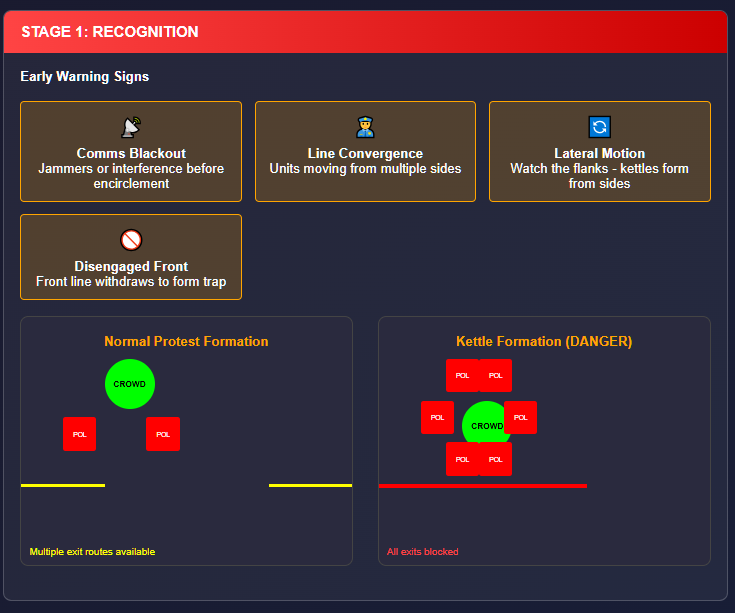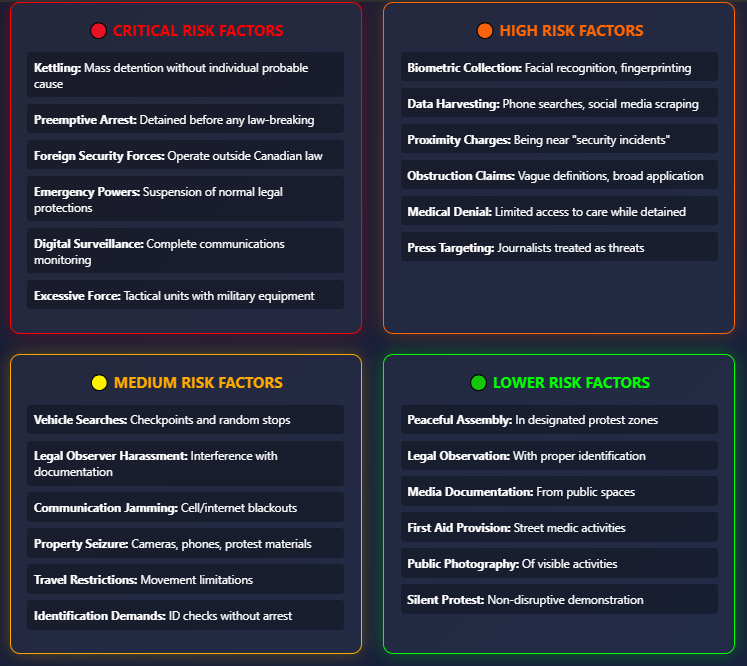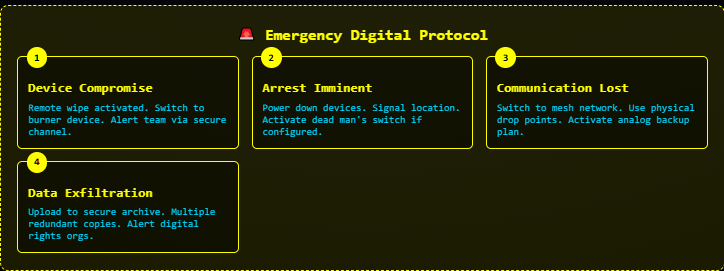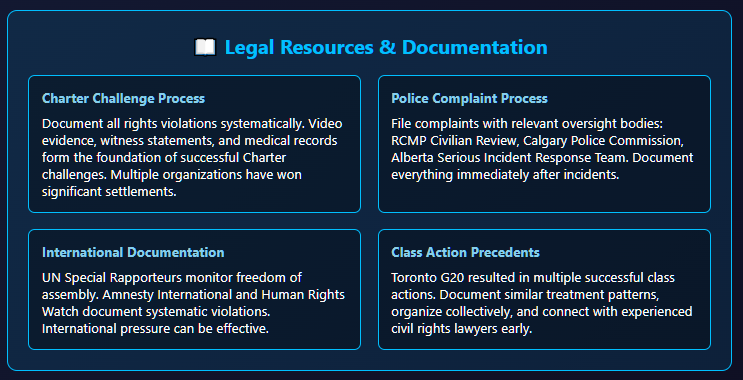Address
304 North Cardinal St.
Dorchester Center, MA 02124
Work Hours
Monday to Friday: 7AM - 7PM
Weekend: 10AM - 5PM

You will not be welcomed.
You will not be seen.
But you must show up.
The 2025 G7 Summit at Kananaskis isn’t just fortified — it’s pre-emptively sterilized. Using drones, biometric scanners, AI risk assessments, and pre-authorized perimeter lockdowns, security planners have built not a fortress, but a signal scrubber. One designed to prevent your voice, your movement, and your metadata from reaching the public sphere.
This isn’t crowd control. It’s narrative control.
This guide is for those determined to rupture that.
The final entry in the G7 Security Series is not an exposé. It’s a manual.
A document for dissenters. A weaponized map.
It draws from 20+ years of summit suppression — Genoa, Toronto, Biarritz — and reframes their lessons not for lawyers, but for you. Protestors. Medics. OSINT monitors. Civilians bearing witness.
Inside: how to detect drone sweeps. How to digitally spoof presence. How to monitor press gagging in real-time. How to subvert biometric checkpointing, avoid pattern-of-life tagging, and legally disrupt the perimeter’s logistics spine. It also includes briefings for lawyers, independent press, and international observers.
This is not a call for chaos.
It is a call for presence — visible, tactical, and documented.

In Canada everyone has a Charter right to “peaceful assembly” (s.2(c)) and free expression (s.2(b))j. These rights protect lawful protests, but they are not absolute – the Charter allows reasonable limits under section 1. During the summit, special security laws will apply. For example, the Security Offences Act (a legacy anti-terror law) designates the RCMP as the lead agency for “security offences.” In practice this means the RCMP (with Calgary Police, Alberta Sheriffs and CAF support) will enforce closures and restrictions around the summit. Note that resisting or obstructing an officer is itself a crime (Criminal Code s.129), and even “disorderly conduct” such as fighting, shouting, swearing or blocking others in public can be charged (Criminal Code s.175). Law enforcement loves to abuse these statutes so, beware, and film all law enforcement interactions. There will also be temporary regulations for the event – e.g. Transport Canada has already announced a 30-nautical-mile no-fly zone around Kananaskis, and the government may invoke any needed emergency security measures (from closed-access zones to communication jamming). In short: the Charter allows peaceful protests, but expect tight limits.
The summit will be policed by an Integrated Safety and Security Group (ISSG) led by the RCMP. ISSG combines federal and local forces: RCMP detachments, Calgary Police Service, Alberta Sheriffs (provincial peace officers), Alberta Parks/Forestry, and the Canadian Armed Forces (support role). Expect a highly visible presence of tactical units and equipment: RCMP’s Emergency Response Teams (ERT/SWAT), Calgary SWAT, and border-security patrols will be on standby. Drones, helicopters and police aircraft will monitor from above, and mobile CCTV and license-plate readers will scan the area. In past Canadian summits (G8/G20), police even used armoured vehicles and jammers. For example, at G8 Kananaskis 2002 soldiers and police operated checkpoints on Hwy 40 and Hwy 742 (Smith-Dorrien) checking everyone’s ID and license plates, and communications were jammed by RCMP/CAF. In short, count on an overwhelmingly securitized zone – the authorities plan to “take back” control of all roads and trails. Do not obstruct officers or their equipment, as that itself is a crime. Even if you do not obstruct, if you are conducting legal protest activities, you may still be arrested pretextually in line with Canada’s long tradition of law enforcement abuse during summits.
Protesting in a securitized zone isn’t about volume — it’s about vector. The goal is not merely to chant at a fence. It’s to bend the perimeter’s logistics, optics, and legality to your advantage.
This is not a call for destruction. This is a call for calculated disruption.
Know when to move. Designate mobile leads per cluster — people with maps, offline GPS, and legal contact cards. If police close in, break into pre-planned escape routes. Document their movements, badge numbers, and language.
Disruption is lawful. Disruption is optical. Disruption is the thing they can’t digitally scrub.
Getting arrested is not failure. It’s a logistical consequence. The real risk is being unprepared — or isolated when it happens.


Remember: The RCMP, Calgary Police, and Alberta Sheriffs operate with overlapping authorities and routinely violate Charter rights during summits. Your best weapon is documentation and coordination. Don’t isolate. Don’t improvise.


They won’t charge first. They’ll trap you first.
Kettling — the tactic of surrounding protestors in a confined space with no escape route — is a preferred method of crowd control at summits. It serves two purposes: depersonalization and detention. It removes your agency, then your liberty.
Kettling is not a glitch. It’s the system working as designed.


In Toronto 2010, over 1,100 were arrested. Most in kettles. Most were peaceful. And most charges were dropped — but the trauma, data, and mugshots stayed.
Don’t just fight the kettle. Outsmart it. Disarm it. Discredit it in real time.

You don’t need a signal to see clearly.
When cell towers fail, livestreams glitch, or jammers kick in, most protestors go blind. Don’t be most protestors. OSINT — Open Source Intelligence — doesn’t require Wi-Fi. It requires eyes, memory, paper, and rhythm.
Your visibility doesn’t end when the feed drops. It begins.
Offline OSINT turns your team into a live sensor array.
While others lose their feed, you keep feeding the truth.

Every action may be recorded. Urban security cameras will blanket Banff/Calgary and trails, police drones and helicopters will survey crowds, and automated license-plate readers will track vehicles. Expect Stingray/IMSI-catchers to sweep for cell devices, and social-media monitoring teams to scrape online posts. In fact, the RCMP has publicly admitted using “Project Wide Awake” to collect protesters’ cell data and compile social-media profiles, and has used bulk metadata tools on large demonstrations. As an example, and while we only object on principle, the RCMP has already been directly collecting Prime Rogue Inc data via its “dragon” server” since this series began. Protect yourself digitally by: using encryption and strong locks. Enable full-disk encryption on smartphones and tablets, use Signal (or similar secure apps) for messaging, and carry a burner phone if needed. Disable fingerprint/face unlock – use a PIN or password lock instead. Cover identifying features: wear sunglasses or a hat (to block facial recognition) and concealing clothing (cover tattoos or distinctive gear). When in vehicles, be aware automatic license-plate readers are everywhere – consider temporary plate covers if feasible and legal.
Above all, be careful with photos and location-sharing. Police and other agencies will monitor livestreams and social media for faces and geotags. Don’t livestream your location in real time, and think twice before posting images of crowds or infrastructure. As one digital rights advocate warns, authorities track protest footage online, so “people should be very cautious when sharing pictures or video” of events. If you do film, avoid capturing bystanders’ faces without consent, not because it is illegal but because it may jeopardize their security, and delete location metadata when sharing.

The perimeter isn’t just physical — it’s epistemic.
State and police actors don’t just deploy riot lines and drone swarms — they deploy false narratives, fake alerts, and digital impersonators. Their goal? To fragment trust, flood the zone, and redirect collective energy toward confusion.
Welcome to psychological perimeter control.
To resist this, protestors must treat information like terrain: map it, vet it, and avoid booby traps.
The goal isn’t to silence uncertainty — it’s to filter noise from action.
You are operating in contested information space.
Treat it like terrain.
Secure it.

Summit security doesn’t end at the checkpoint. It moves across hashtags, signal towers, and the narrative trenches of social media. What you say online — or fail to say — will be monitored, scraped, labeled, and possibly weaponized against you.
This is the disinformation front. You are already in it.
State and private-sector actors will use OSINT tools to scrape livestreams, facial data, protest maps, and online chatter. Protester forums will be infiltrated. Bad actors will amplify rumors or deploy fake footage to discredit events. Several summits, including G20 Toronto and G7 Biarritz, saw real-time surveillance and planted narratives designed to disorient the public.
Mitigation:
Remember: narrative control is part of perimeter control. If you can’t reach people with your voice or your lens, you’ve already been kettled — digitally.
Pack smart: Carry a protest kit with at least 1–2 L of water, non-perishable snacks, sunscreen and high-energy food. Include protective gear: N95 mask or bandana for tear gas, safety goggles for chemical irritants or projectiles, and sturdy shoes/boots for rough terrain. Bring a basic first-aid kit (bandages, antiseptic wipes, pain relievers). If you take prescription medication (e.g. inhalers, EpiPen), pack extra for at least 24–36 hours. It’s also wise to carry a small flashlight, whistle, and a charged power bank for your phone.
Identification and contacts: Always have government ID (driver’s license or passport) on you. Keep a written or digital “grab card” with emergency contacts and any medical conditions. Some activists write their name, a phone number and allergies on their arm in permanent marker. Memorize or store the number of a legal-aid hotline or civil liberties organization.
Legal support: Volunteer legal observers often accompany protests to document police actions. These observers (from groups like the Canadian Association of Legal Observers, or civil liberties groups) wear identifiable vests and note badge numbers; they do not stop police from acting. You should keep their number handy. Organizations like the Canadian Civil Liberties Association (CCLA) and local legal aid societies may set up emergency hotlines for protesters. If you witness or experience rights violations, call them immediately.
Medical help: Know where to go for serious injuries. In Banff, the Mineral Springs Hospital (305 Lynx St.) has a 24-hour emergency department. In Calgary, the Peter Lougheed Centre (3500 26 Ave NE) is a Level 1 trauma centre open 24/7. (Canmore’s hospital is smaller; Foothills Medical Centre in Calgary is another trauma hospital.). Prime Rogue Inc has also learned that the Sheldon Chumir Urgent Care in downtown Calgary (1213 4 St SW) is being staged as a protest “aid” clinic for minor injuries but we believe that it is likely to be coopted by law enforcement and other security forces. Volunteers known as “street medics” often roam protests offering first aid. For example, the Toronto Street Medics group regularly tended to G20 demonstrators (providing water, sunscreen and treatment for pepper spray exposure). Do not rely solely on public EMS; bring basic supplies and seek out medics if you can.
Not all bodies are policed the same — and the perimeter knows it.
Summit security doesn’t treat protestors equally. Queer, trans, racialized, disabled, and visibly non-conforming individuals face amplified surveillance, risk, and abuse — not as collateral, but by design.
This is a guide for reading the terrain through those bodies.

Intersectionality isn’t a buzzword — it’s your risk profile.
Know how your body will be read.
Plan like your visibility is a variable.
And never march alone.

Kananaskis terrain: The summit site is in rugged Rockies (Kananaskis Trail area). Expect steep, forested mountains and sudden weather changes. In June it can still be chilly or rainy (snow at higher elevations). Dress in layers, pack rain gear and sturdy hiking boots. There is little cell service off-road. Trails and parks near the venue will be closed entirely, so do not plan hiking or camping nearby.
Road closures & checkpoints: Major routes (Hwy 1, Hwy 40, Spray Lakes Hwy) will likely have checkpoints or closures. In 2002, RCMP and soldiers set up multiple roadblocks on Hwy 40 and the Smith-Dorrien (Hwy 742), screening every vehicle with wands and checking licenses/IDs. Motorists were ordered to turn around unless on official business. Fuel up in Calgary or Banff and carry extra gas. Have alternate routes planned: for example, go early or late to avoid convoy windows. Don’t attempt off-road detours; the area will be monitored by air.
Weather and wilderness: Always assume you could be stuck outdoors. Bring water purification (tablets or filter) and a small sleeping bag/blanket in case you are forced to retreat into nature. Share your itinerary with friends or family. Cell phones might fail – carry paper maps or offline GPS if hiking in any open areas. Finally, remember the simplest rule: stay with a group, know at least two ways out of an area, and stick to well-traveled roads.
Heads of state (President Trump, Prime Minister Carney, etc.) will arrive with their own protective details. For example, the U.S. Secret Service will guard President Trump’s motorcade, and France’s GIGN will secure President Macron. These foreign agents have limited authority on Canadian soil (they protect their principal only). However, their vehicles and motorcades are fully armed and shielded; they may attempt to take extra-legal activities if you approach or attempt to film them, as they will treat this as a security violation. In past summits it was made clear that any interference with a motorcade (e.g. blocking a street or touching the car) would be met with force by local or foreign security. Even photographing certain military or police assets can cause detention or charges in spite of your right, as a Canadian, to film anything you can see from a public right of way. In short: respect the cordons around VIPs, and understand that foreign security units enforce their own strict rules – and will not be held accountable if they violate your Charter Rights.
Not all summit security is bound by Canadian law — and some of it doesn’t care.
When G7 leaders travel, they bring not only armored cars and bodyguards, but full-spectrum protective teams operating under ambiguous legal status. From the U.S. Secret Service to France’s GIGN and Japan’s SP, these teams are authorized to protect their principals — and not much else. But in practice, they act with broad impunity.
And protestors often get caught in the blind spot.

They’re not supposed to be above the law.
But they’ve been trained to act as if they are.
Treat foreign security like a drone: avoid, log, and counter-signal.
Past Canadian summits offer lessons. At G8 Kananaskis (2002), the site was enclosed in a “13-mile security cordon.” Civilians were turned back by armed guards and checkpoints, and protest activity was mostly limited to outside the perimeter. Cellular and radio signals were jammed by RCMP and military for security. In practice, few protesters even reached the actual summit.
At the Toronto G20 (2010), large-scale protests met very heavy policing. Over 20,000 officers and soldiers encircled Toronto’s downtown, and police kettled crowds on multiple occasions. More than 1,100 people were detained (the largest mass arrest in Canadian history). Officers used tear gas, pepper spray and rubber bullets on crowds. In the aftermath, Ontario courts found these tactics violated Charter rights, and the Toronto Police Service paid a C$16.5 million settlement to those wrongfully held. The lesson: even peaceful protesters (and bystanders/journalists) will be swept up; always document and demand the reasons for any encirclement. Police will continue to engage in these Charter-violating tactics because a protracted lawsuit is more expedient than acting constitutionally.
At the G7 Charlevoix (2018), the remoteness of the site again kept demonstrations small. Hundreds of Quebecois and out-of-province activists marched in Quebec City (a day’s drive away), but direct actions near La Malbaie were limited. Human-rights observers reported that police forces (including Québec provincial police and RCMP) were heavily armed and used intimidation (harsh language, blocking roads) even against peaceful groups. Many were subject to “pre-emptive” detentions or kettling despite no overt law-breaking. Amnesties’ report noted that the display of assault rifles and armored vehicles created a climate of fear. Expect the same for this summit. In line with Carl Schmitt’s theory of the exception, your Charter rights become irrelevant to law enforcement and the military in these contexts.
Media framing and aftermath: Officials often emphasize only isolated violence (e.g. property damage, scuffles) and downplay legitimate protest. After Toronto 2010, news focused on burning police cars, overshadowing stories of innocent people trapped and mistreated. By contrast, rights organizations and lawyers have shown that heavy-handed tactics often backfire legally. Stay lawful and visible. Document everything with video or photos (if safe to do so), and note officers’ badge numbers. If detained, ask later for a receipt of any search or charge, and seek legal advice immediately. Remember: most damages at past summits were minor compared to the public outrage over police misconduct. History teaches that well-prepared, peaceful protesters can withstand intense security – as long as they know their rights and stay together.
The summit isn’t over when you leave — that’s when the narrative war begins.
Once the tear gas clears and the checkpoints reopen, the G7 doesn’t simply pack up. It writes history — with press releases, press kits, and photo ops of smiling leaders. Your job isn’t just to disrupt. It’s to outlast the spin.
This section is your final protocol: what to do after the action ends.

This isn’t about ego or exposure.
It’s about narrative anchoring.
Police forces have PR departments.
Protest movements need archives.
By design, you are meant to be invisible.
By function, you are already classified — as a disruption, a digital node, or a “non-permitted presence.”
But if you’re reading this, you’ve already rejected the premise.
The 2025 G7 Summit doesn’t fear violence. It fears witnessing.
It fears the return of uncontrolled narrative space. It fears protestors who aren’t just present — but networked, strategic, and unafraid.
So document everything.
Spoil the optics. Map the gear. Confirm the drone paths. Archive the police lies in real time.
The summit was designed without you in it.
Insert yourself anyway.
This series ends here — but your presence begins.
The above does not constitute legal advice. You should verify the content’s factual accuracy, and consult an attorney regarding legal questions. This information is provided for educational purposes and represents the opinion of Prime Rogue Inc staff.
[…] Meanwhile, any civil society presence was tightly controlled. Authorities designated just three offi… The theatre of “engagement” existed, but only behind figurative one-way glass: leaders could gesture toward the concepts of democracy and transparency while ensuring that inconvenient voices remained out of earshot. As one protest organizer in Calgary quipped, they hoped their rallies – livestreamed into the secure zone – might “ambush [Modi] for the next 48 hours” by forcing leaders to actually notice dissent. But the summit’s stage managers had done everything to prevent any such ambush. […]